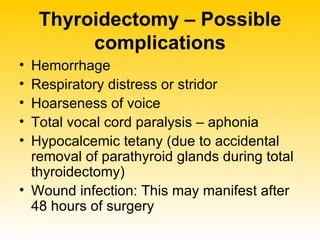While caring for a client one day following a thyroidectomy, the practical nurse (PN) notes that the client's voice is hoarse. What action should the PN take?
Notify the unit charge nurse of the finding.
Administer humidified oxygen per nasal cannula.
Obtain a cup of ice chips for the client.
Ensure that the drainage device is compressed.
The Correct Answer is A
Hoarseness or voice changes after thyroidectomy can be indicative of injury or irritation to the recurrent laryngeal nerve, which is responsible for controlling the vocal cords. This is a potential complication of the surgery and should be reported to the charge nurse or healthcare provider for further evaluation and management.

B. Administer humidified oxygen per nasal cannula: This option is not appropriate for addressing hoarseness in a client following a thyroidectomy. Hoarseness after a thyroidectomy is typically related to vocal cord injury or irritation, and providing humidified oxygen would not directly address this issue. It is important to notify the charge nurse or healthcare provider for further evaluation and management.
C. Obtain a cup of ice chips for the client: Providing ice chips is not the appropriate action for hoarseness following a thyroidectomy. Ice chips are typically used to provide hydration and comfort to clients, but they do not directly address the underlying cause of hoarseness, which in this case may be vocal cord injury or irritation. It is important to notify the charge nurse or healthcare provider for appropriate evaluation and management.
D. Ensure that the drainage device is compressed: While ensuring proper compression of a drainage device is important for preventing complications such as bleeding or infection, it is not directly related to the client's hoarseness. Hoarseness after a thyroidectomy is more likely related to vocal cord injury or irritation, and notifying the charge nurse or healthcare provider is necessary for further assessment and management.
Nursing Test Bank
Naxlex Comprehensive Predictor Exams
Related Questions
Correct Answer is ["C","E"]
Explanation
C. Regularly selects salty snacks to eat in the evening: Consuming excessive amounts of sodium (found in salty snacks) can increase blood pressure and contribute to the development of hypertension.
E. Chews tobacco while playing baseball every weekend: Tobacco use, including chewing tobacco, is associated with an increased risk of hypertension and other cardiovascular diseases.
The other choices are incorrect because they do not directly contribute to an increased risk of hypertension:
A. Drinks a protein supplement for breakfast every day: Consuming a protein supplement for breakfast does not necessarily increase the risk of hypertension. However, it is important to note that some protein supplements may contain added sodium, which can contribute to hypertension if consumed in excessive amounts.
B. Eats eight ounces of nonfat yogurt for lunch daily: Eating nonfat yogurt is generally considered a healthy food choice. However, unless the yogurt is high in added sodium, it would not significantly increase the risk of hypertension.
D. Walks briskly for two miles every day after work: Regular exercise, such as brisk walking, is generally beneficial for cardiovascular health and can help lower blood pressure. It is unlikely to increase the risk of hypertension.
Correct Answer is B
Explanation
Smokeless tobacco, such as chewing tobacco or snuff, still contains harmful substances, including nicotine and various chemicals. It is associated with several health risks, including an increased risk of oral, esophageal, and pancreatic cancers, as well as gum disease, tooth loss, and nicotine addiction.
Incorrect:
A. By providing this information, the nurse can help the client make an informed decision about their smoking cessation plan. It is crucial to emphasize that quitting tobacco altogether is the best approach to reduce the risk of cancer and improve overall health.
C. The nurse should not encourage the client to continue with the plan to switch to smokeless tobacco as a means of reducing the risk for cancer. Instead, the focus should be on supporting the client's efforts to quit tobacco entirely and providing appropriate resources and interventions to facilitate smoking cessation.
D. Addressing the concern about weight gain when quitting smoking is also important, but it should be done in the context of promoting healthy lifestyle changes and offering strategies to manage weight during the smoking cessation process.
Whether you are a student looking to ace your exams or a practicing nurse seeking to enhance your expertise , our nursing education contents will empower you with the confidence and competence to make a difference in the lives of patients and become a respected leader in the healthcare field.
Visit Naxlex, invest in your future and unlock endless possibilities with our unparalleled nursing education contents today
Report Wrong Answer on the Current Question
Do you disagree with the answer? If yes, what is your expected answer? Explain.
Kindly be descriptive with the issue you are facing.
